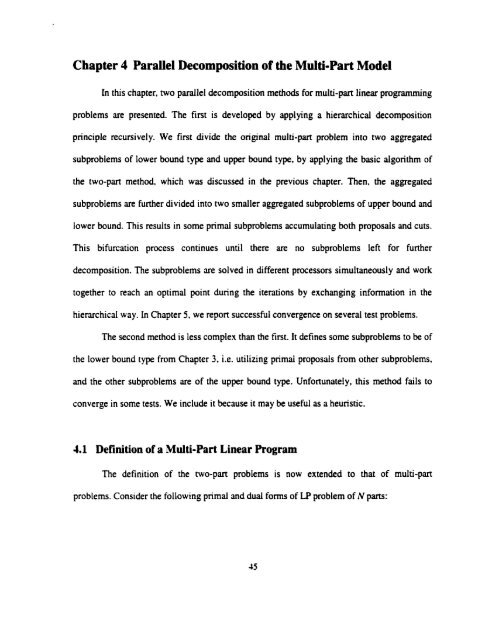X - UWSpace - University of Waterloo
X - UWSpace - University of Waterloo
X - UWSpace - University of Waterloo
You also want an ePaper? Increase the reach of your titles
YUMPU automatically turns print PDFs into web optimized ePapers that Google loves.
Chapter 4 Paraiiel Decomposition <strong>of</strong> the Multi-Part Mode1<br />
In this chapter, two parallel decomposition methods for multi-part iinear programrning<br />
problems are presented. The fint is developed by applying a hierarchical decomposition<br />
principle recunively. We first divide the original multi-part problem into two aggregated<br />
subproblems <strong>of</strong> lower bound type and upper bound type, by applying the basic algorithm <strong>of</strong><br />
the two-part method. which was discussed in the previous chapter. Then. the aggregated<br />
subproblems are further divided into two smaller aggregated subproblems <strong>of</strong> upper bound and<br />
lower bound. This results in some primai subproblems accumulating both proposais and cuts.<br />
This bifurcation process continues until there are no subproblerns left for funher<br />
decomposition. The subproblems are solved in different processon simuItaneously and work<br />
together to reach an optimal point during the iterations by exchanging information in the<br />
hierarchicd way. In Chapter 5, we repon successhl convergence on several test problems.<br />
The second method is less complen than the first. It defines some subproblems to be <strong>of</strong><br />
the lower bound type from Chapter 3, Le. utilizing primal proposais from other subproblems,<br />
and the other subproblems are <strong>of</strong> the upper bound type. Unfortunately, this method fails to<br />
converge in some tests. We include it because it may be useful as a heuristic.<br />
4.1 Definition <strong>of</strong> a Multi-Part Linear Program<br />
The definition <strong>of</strong> the two-part problems is now extended to that <strong>of</strong> multi-part<br />
problems. Consider the following prima1 and dual forms <strong>of</strong> LP problem <strong>of</strong> N parts:
















